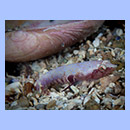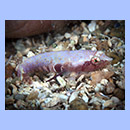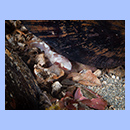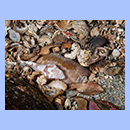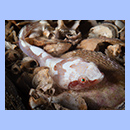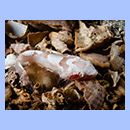- Kingdom: Animalia
- Phylum: Chordata
- Subphylum: Vertebrata
- Superclass: Gnathostomata
- Class: Actinopterygii
- Order: Gobiesociformes
- Family: Gobiesocidae
- Scientific name: Diplecogaster bimaculata bimaculata
- Norwegian: dobbeltsuger
Characteristics:
The body length rarely exceeds 6 cm. The pelvic fins are transformed into a sucker used to cling to rocks or other hard substrates. The brilliant coloration can be very variable, but the body is often red with violet, blue, brown or yellow spots. Males can be identified from a purple spot, circled by yellow, right behind the pectoral fin. The head is small and the body somewhat flattened. The two-spotted clingfish may be confused with the similar small-headed cling fish, Apletodon microcephalus, but this is not registered in Norway. You have to study their teeth to distinguish the two species.
Habitat:
It prefers rocky, current exposed locations on a depth range from 10 to 20 meters, but it is registered as deep as 100 meters. On bivalve banks it may seek shelter under empty shells.
Distribution:
The two-spotted clingfish is known in the East Atlantic Ocean, from Gibraltar to Scandinavia and the British Isles. In Norway it is registered as far north as Trøndelag.
